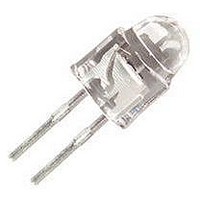BPV11 Vishay, BPV11 Datasheet - Page 6

BPV11
Manufacturer Part Number
BPV11
Description
Photodetector Transistors NPN Phototransistor 80V 150mW 450-1080nm
Manufacturer
Vishay
Type
Chipr
Specifications of BPV11
Maximum Power Dissipation
150 mW
Maximum Dark Current
50 nA
Maximum Operating Temperature
+ 100 C
Package / Case
T-1 3/4
Transistor Polarity
NPN
Wavelength Typ
850nm
Power Consumption
150mW
Viewing Angle
15°
No. Of Pins
2
Light Current
10mA
Dark Current
50nA
C-e Breakdown Voltage
70V
Current Rating
50mA
Transistor Case Style
T-1 3/4
Current Ic Typ
10mA
Fall Time Tf
3.8µs
Half Angle
15°
Rohs Compliant
Yes
Voltage - Collector Emitter Breakdown (max)
70V
Current - Collector (ic) (max)
10mA
Current - Dark (id) (max)
50nA
Wavelength
850nm
Power - Max
150mW
Mounting Type
Through Hole
Orientation
Top View
Svhc
No SVHC (20-Jun-2011)
Phototransistor Type
Phototransistor
Polarity
NPN
Number Of Elements
1
Lens Type
Water Clear
Collector-emitter Voltage
70V
Collector Current (dc) (max)
50mA
Collector-emitter Sat Volt (max)
0.3V
Dark Current (max)
50nA
Power Dissipation
150mW
Peak Wavelength
850nm
Half-intensity Angle
30deg
Mounting
Through Hole
Pin Count
2
Package Type
T-1 3/4
Lead Free Status / RoHS Status
Lead free / RoHS Compliant
Lead Free Status / RoHS Status
Lead free / RoHS Compliant, Lead free / RoHS Compliant
Available stocks
Company
Part Number
Manufacturer
Quantity
Price
BPV11
Vishay Semiconductors
Ozone Depleting Substances Policy Statement
It is the policy of Vishay Semiconductor GmbH to
1. Meet all present and future national and international statutory requirements.
2. Regularly and continuously improve the performance of our products, processes, distribution and
It is particular concern to control or eliminate releases of those substances into the atmosphere which are
known as ozone depleting substances (ODSs).
The Montreal Protocol (1987) and its London Amendments (1990) intend to severely restrict the use of ODSs
and forbid their use within the next ten years. Various national and international initiatives are pressing for an
earlier ban on these substances.
Vishay Semiconductor GmbH has been able to use its policy of continuous improvements to eliminate the use
of ODSs listed in the following documents.
1. Annex A, B and list of transitional substances of the Montreal Protocol and the London Amendments
2. Class I and II ozone depleting substances in the Clean Air Act Amendments of 1990 by the Environmental
3. Council Decision 88/540/EEC and 91/690/EEC Annex A, B and C (transitional substances) respectively.
Vishay Semiconductor GmbH can certify that our semiconductors are not manufactured with ozone depleting
substances and do not contain such substances.
www.vishay.com
6
operatingsystems with respect to their impact on the health and safety of our employees and the public, as
well as their impact on the environment.
respectively
Protection Agency (EPA) in the USA
customer application by the customer. Should the buyer use Vishay Semiconductors products for any
unintended or unauthorized application, the buyer shall indemnify Vishay Semiconductors against all
Parameters can vary in different applications. All operating parameters must be validated for each
claims, costs, damages, and expenses, arising out of, directly or indirectly, any claim of personal
Vishay Semiconductor GmbH, P.O.B. 3535, D-74025 Heilbronn, Germany
damage, injury or death associated with such unintended or unauthorized use.
Telephone: 49 (0)7131 67 2831, Fax number: 49 (0)7131 67 2423
We reserve the right to make changes to improve technical design
and may do so without further notice.
Document Number 81504
Rev. 1.4, 08-Mar-05








